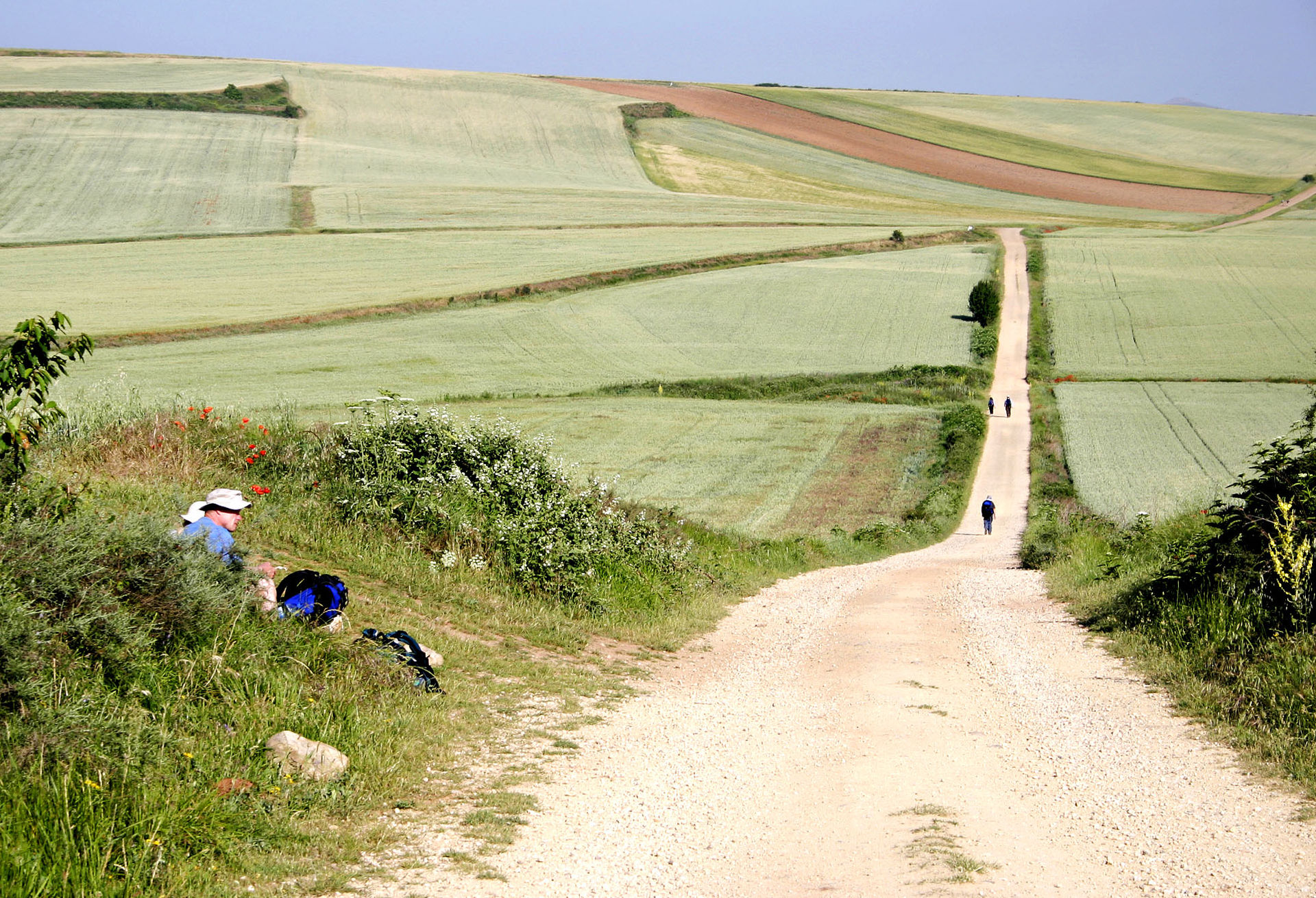
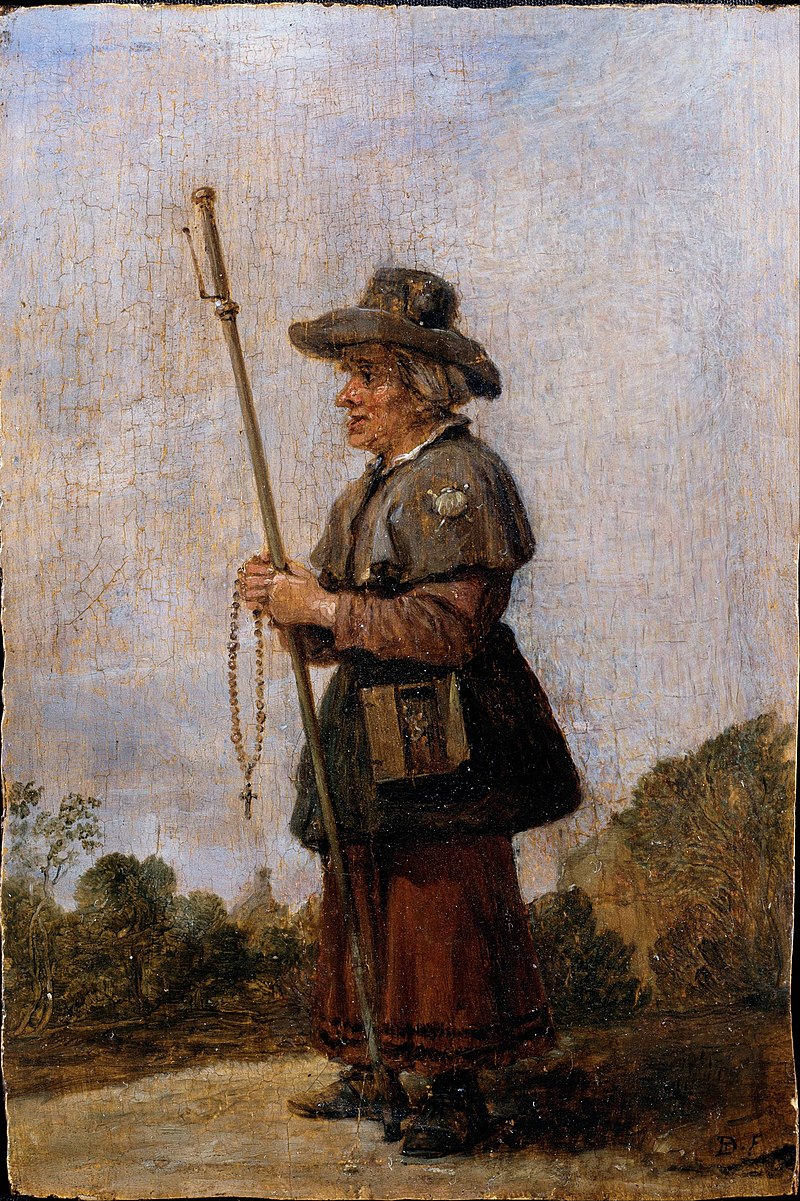
巡礼
Pilgrimage


サ
ンティアゴ・デ・コンポステーラの巡礼路 / David Teniers the Younger: Flemish Pilgrim
☆ 巡礼とは、聖地への旅であり、個人的な変容をもたらし、その後に日常生活に戻ることである。
Distinguishing
pilgrimage from tourism, according to Frank Fahey
| A
pilgrimage is a journey to a holy place, which can lead to a personal
transformation, after which the pilgrim returns to their daily
life.[1][2][3] |
巡礼とは、聖地への旅であり、個人的な変容をもたらし、その後に日常生
活に戻ることである[1][2][3]。 |
| Pilgrimages
frequently involve a journey or search of moral or spiritual
significance. Typically, it is a journey to a shrine or other location
of importance to a person's beliefs and faith, although sometimes it
can be a metaphorical journey into someone's own beliefs. Many religions attach spiritual importance to particular places: the place of birth or death of founders or saints, or to the place of their "calling" or spiritual awakening, or of their connection (visual or verbal) with the divine, to locations where miracles were performed or witnessed, or locations where a deity is said to live or be "housed", or any site that is seen to have special spiritual powers. Such sites may be commemorated with shrines or temples that devotees are encouraged to visit for their own spiritual benefit: to be healed or have questions answered or to achieve some other spiritual benefit. A person who makes such a journey is called a pilgrim. As a common human experience, pilgrimage has been proposed as a Jungian archetype by Wallace Clift and Jean Dalby Clift.[4] Some research has shown that people who engage in pilgrimage walks enjoy biological, psychological, social, and spiritual therapeutic benefits.[5] The Holy Land acts as a focal point for the pilgrimages of the Abrahamic religions of Judaism, Christianity, and Islam. According to a Stockholm University study in 2011, these pilgrims visit the Holy Land to touch and see physical manifestations of their faith, confirm their beliefs in the holy context with collective excitation, and connect personally to the Holy Land.[6] The Catholic priest Frank Fahey writes that a pilgrim is "always in danger of becoming a tourist" and vice versa, and identifies eight differences between the two:[7] |
巡礼は、道徳的または精神的な意味を持つ旅や探索を伴うことが多い。一
般的には、その人の信念や信仰にとって重要な神社やその他の場所への旅であるが、時には、その人自身の信念への隠喩的な旅となることもある。 多くの宗教は、特定の場所に精神的な重要性を置いている。開祖や聖人の出生地や死亡地、「召命」や精神的な目覚めの場所、神とのつながり(視覚的または言 語的)、奇跡が行われた場所や目撃された場所、神が住んでいると言われる場所や「収容」されている場所、特別な霊的な力を持つと見られる場所などである。 そのような場所は、神社や寺院で記念されることがあり、信者は自分の霊的な利益のために訪れるよう奨励される。 このような旅をする人は巡礼者と呼ばれる。ウォレス・クリフトとジーン・ダルビー・クリフトによって、巡礼はユングのアーキタイプとして提唱されている [4]。いくつかの研究によると、巡礼の旅に参加する人々は、生物学的、心理学的、社会的、精神的な治療効果を享受することが示されている[5]。 聖地は、ユダヤ教、キリスト教、イスラム教のアブラハム宗教の巡礼の中心地として機能している。2011年のストックホルム大学の研究によると、これらの 巡礼者は、自分たちの信仰の物理的な現れに触れたり見たりするために聖地を訪れ、集団的な興奮とともに聖なる状況における自分たちの信念を確認し、個人的 に聖地とつながる[6]。 カトリック司祭のフランク・フェイヒーは、巡礼者は「常に観光客になる危険性がある」とし、その逆もまたしかりであるとした上で、両者の違いを以下の8つ に分類している[7]。 |
| Ancient Greece The Eleusinian mysteries included a pilgrimage. The procession to Eleusis began at the Athenian cemetery Kerameikos and from there the participants walked to Eleusis, along the Sacred Way (Ἱερὰ Ὁδός, Hierá Hodós).[8] Bahá'í Faith Main article: Bahá'í pilgrimage Bahá'u'lláh decreed pilgrimage to two places in the Kitáb-i-Aqdas: the House of Bahá'u'lláh in Baghdad, Iraq, and the House of the Báb in Shiraz, Iran. Later, ʻAbdu'l-Bahá designated the Shrine of Bahá'u'lláh at Bahji, Israel as a site of pilgrimage.[9] The designated sites for pilgrimage are currently not accessible to the majority of Bahá'ís, as they are in Iraq and Iran respectively, and thus when Bahá'ís currently refer to pilgrimage, it refers to a nine-day pilgrimage which consists of visiting the holy places at the Bahá'í World Centre in northwest Israel in Haifa, Acre, and Bahjí.[9] Buddhism Main article: Buddhist pilgrimage 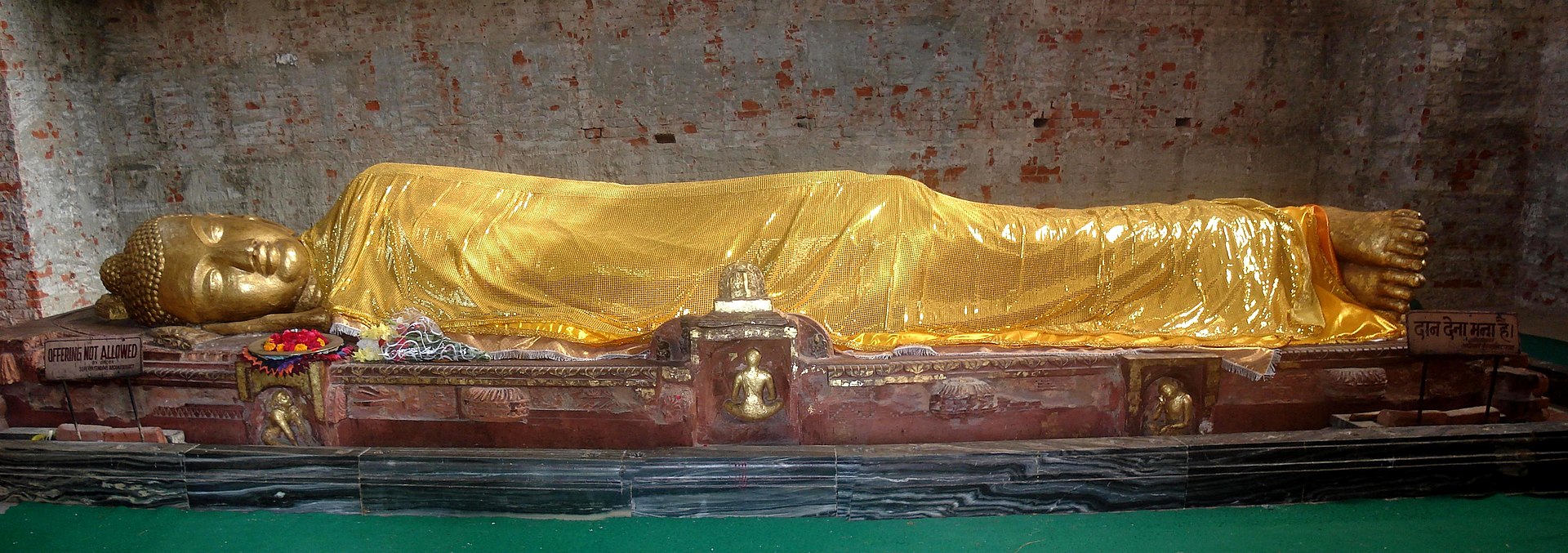 Ancient excavated Buddha-image at the Mahaparinirvana Temple, Kushinagar 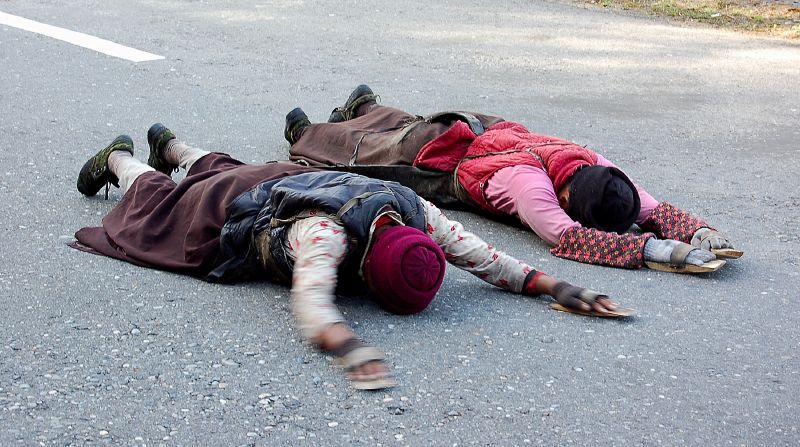 Tibetans on a pilgrimage to Lhasa, doing full-body prostrations, often for the entire length of the journey In India and Nepal, there are four places of pilgrimage which are tied to the life of Gautama Buddha: Lumbini: Buddha's birthplace (in Nepal) Bodh Gaya: place of Enlightenment (in the current Mahabodhi Temple, Bihar, India) Sarnath: (formally Isipathana, Uttar pradesh, India) where he delivered his first sermon (Dhammacakkappavattana Sutta), and the Buddha taught about the Middle Way, the Four Noble Truths and Noble Eightfold Path Kusinara: (now Kusinagar, India) where he attained mahaparinirvana (died) Other pilgrimage places in India and Nepal connected Gautama Buddha's life are: Savatthi, Pataliputta, Nalanda, Gaya, Vesali, Sankasia, Kapilavastu, Kosambi, Rajagaha. Other famous places for Buddhist pilgrimage include: India: Sanchi, Ellora Caves, Ajanta Caves, also see Buddhist pilgrimage sites in India Thailand: Wat Phra Kaew, Wat Pho, Wat Doi Suthep, Phra Pathom Chedi, Sukhothai, Ayutthaya Tibet: Lhasa (traditional home of the Dalai Lama), Mount Kailash, Lake Nam-tso Cambodia: Wat Botum, Wat Ounalom, Wat Botum, Silver Pagoda, Angkor Wat Sri Lanka: Temple of the Tooth, Polonnaruwa, (Kandy), Anuradhapura Laos: Pha That Luang, Luang Prabang Malaysia: Kek Lok Si, KL Buddhist Maha Vihara Myanmar: Shwedagon Pagoda, Mahamuni Buddha Temple, Kyaiktiyo Pagoda, Bagan, Sagaing Hill, Mandalay Hill, Nepal: Maya Devi Temple, Boudhanath, Swayambhunath Indonesia: Borobudur, Mendut, Sewu Taiwan: Fo Guang Shan, Dharma Drum Mountain, Chung Tai Shan, Tzu Chi Hong Kong: Po Lin Monastery China: Yung-kang, Lung-men caves. The Four Sacred Mountains Japan: Shikoku Pilgrimage, 88 temple pilgrimage on the island of Shikoku Japan 100 Kannon Pilgrimage, pilgrimage composed of the Saigoku, Bandō and Chichibu pilgrimages Saigoku Kannon Pilgrimage, pilgrimage in the Kansai region Bandō Sanjūsankasho, pilgrimage in the Kantō region Chichibu 34 Kannon Sanctuary, pilgrimage in Saitama Prefecture Chūgoku 33 Kannon Pilgrimage, pilgrimage in the Chūgoku region Kumano Kodō Mount Kōya Christianity Main article: Christian pilgrimage 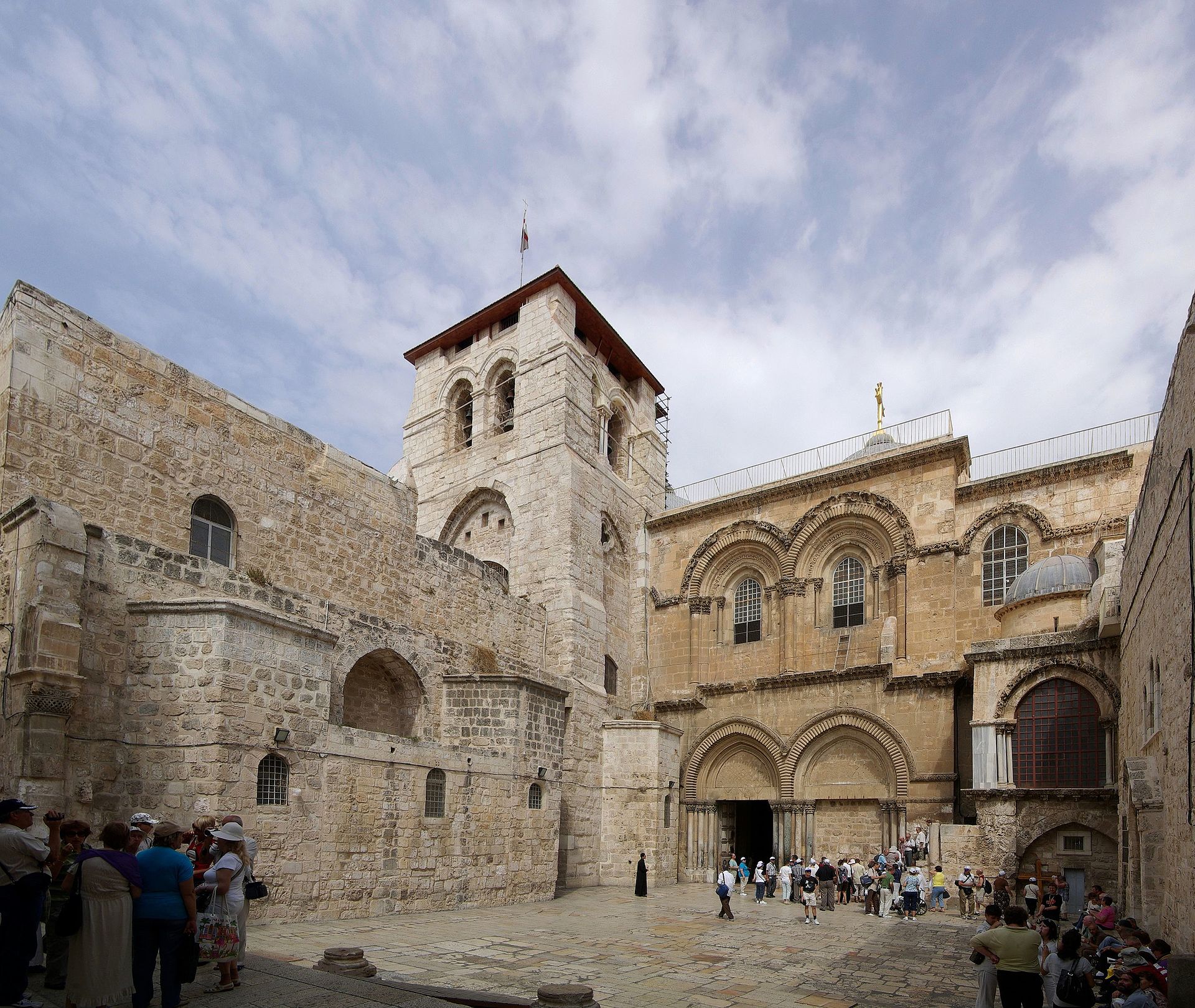 Church of the Holy Sepulchre in Jerusalem according to tradition is the site where Jesus was crucified and resurrected 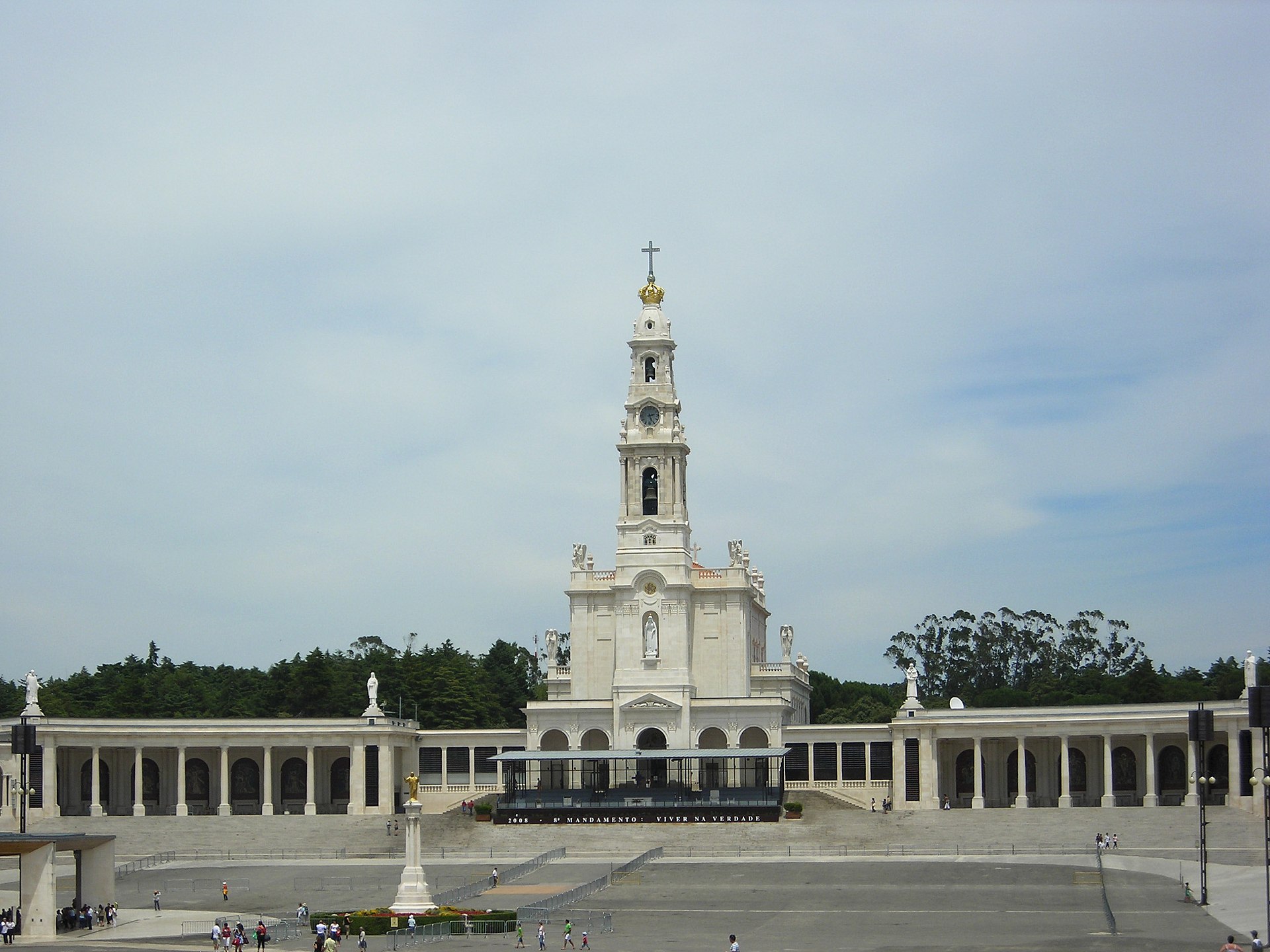 The Sanctuary of Our Lady of Fátima is one of the largest pilgrimage sites (Marian shrine) in the world. Christian pilgrimage was first made to sites connected with the birth, life, crucifixion and resurrection of Jesus. Aside from the early example of Origen in the third century, surviving descriptions of Christian pilgrimages to the Holy Land date from the 4th century, when pilgrimage was encouraged by church fathers including Saint Jerome, and established by Saint Helena, the mother of Constantine the Great.[10] The purpose of Christian pilgrimage was summarized by Pope Benedict XVI in this way: To go on pilgrimage is not simply to visit a place to admire its treasures of nature, art or history. To go on pilgrimage really means to step out of ourselves in order to encounter God where he has revealed himself, where his grace has shone with particular splendour and produced rich fruits of conversion and holiness among those who believe. Above all, Christians go on pilgrimage to the Holy Land, to the places associated with the Lord's passion, death and resurrection. They go to Rome, the city of the martyrdom of Peter and Paul, and also to Compostela, which, associated with the memory of Saint James, has welcomed pilgrims from throughout the world who desire to strengthen their spirit with the Apostle's witness of faith and love.[11] Pilgrimages were, and are, also made to Rome and other sites associated with the apostles, saints and Christian martyrs, as well as to places where there have been apparitions of the Virgin Mary. A popular pilgrimage journey is along the Way of St. James to the Santiago de Compostela Cathedral, in Galicia, Spain, where the shrine of the apostle James is located. A combined pilgrimage was held every seven years in the three nearby towns of Maastricht, Aachen and Kornelimünster where many important relics could be seen (see: Pilgrimage of the Relics, Maastricht). Chaucer's The Canterbury Tales recounts tales told by Christian pilgrims on their way to Canterbury Cathedral and the shrine of Thomas Becket. Marian pilgrimages remain very popular in Latin America. Hinduism See also: Tirtha (Hinduism), Hindu pilgrimage sites, Hinduism § Pilgrimage, and Yatra 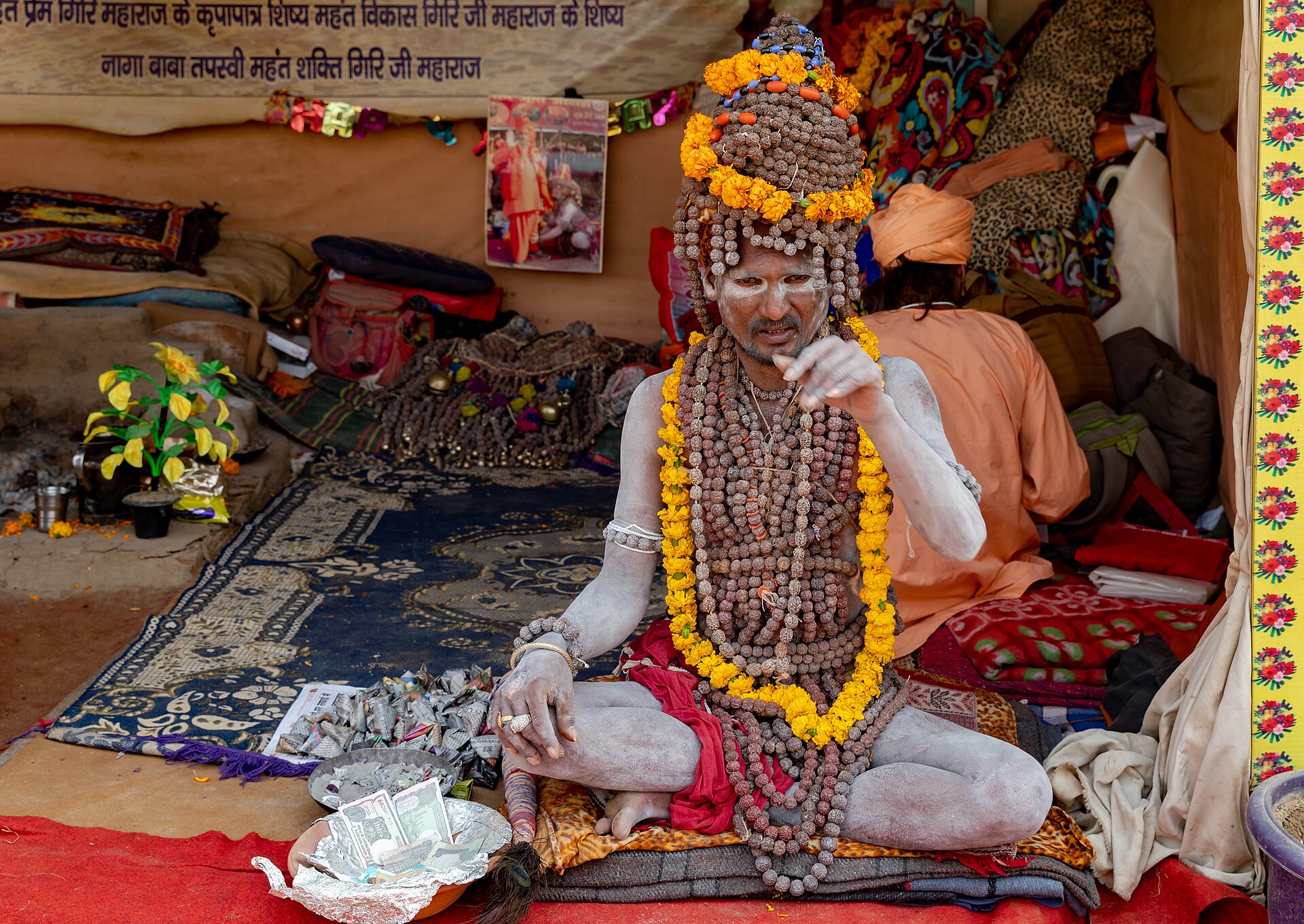 Kumbh Mela According to Karel Werner's Popular Dictionary of Hinduism, "most Hindu places of pilgrimage are associated with legendary events from the lives of various gods.... Almost any place can become a focus for pilgrimage, but in most cases they are sacred cities, rivers, lakes, and mountains."[12] Hindus are encouraged to undertake pilgrimages during their lifetime, though this practice is not considered absolutely mandatory. Most Hindus visit sites within their region or locale. 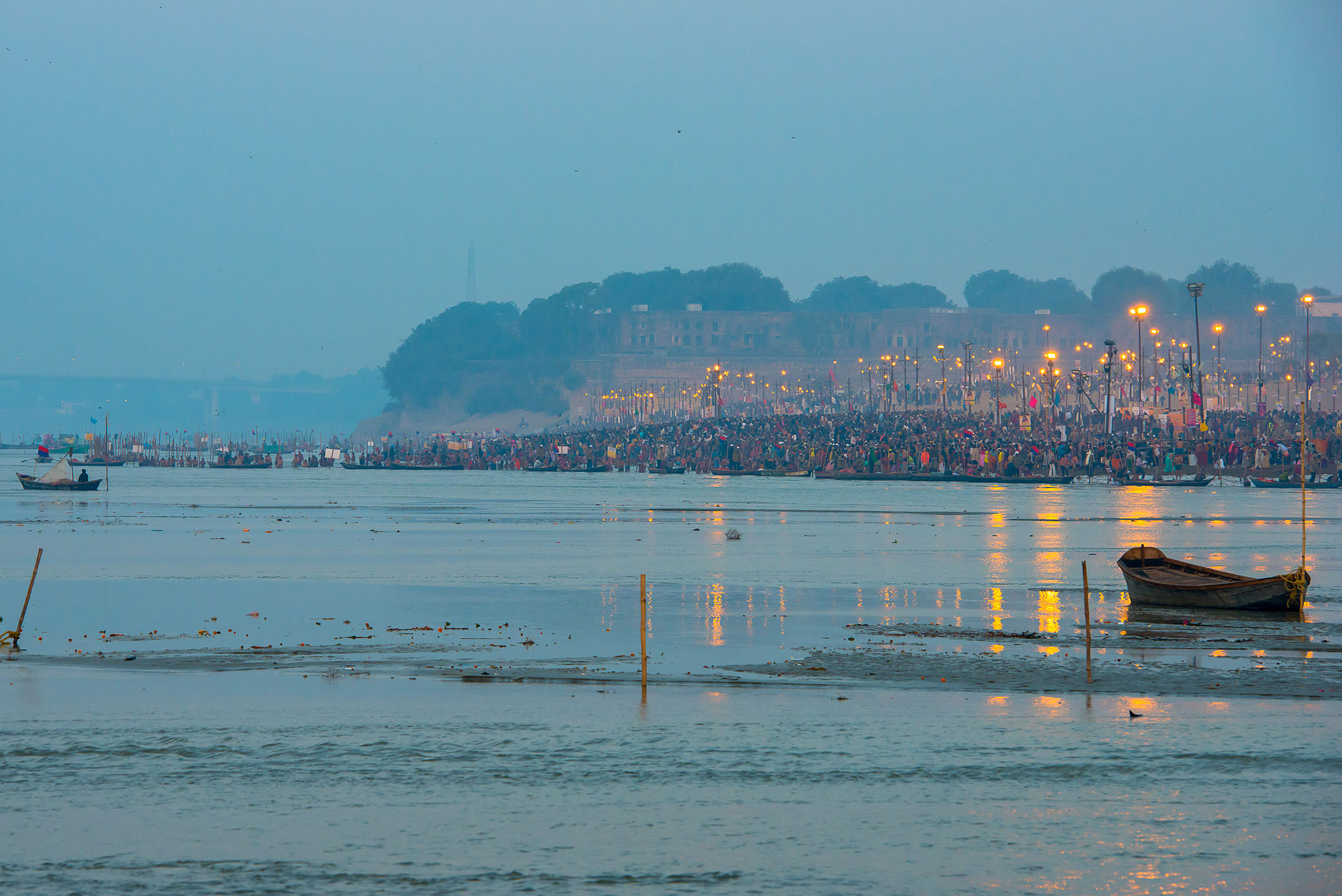 Pilgrims along the Ganges during Prayag Kumbh Mela Kumbh Mela: Kumbh Mela is one of the largest gatherings of humans in the world where pilgrims gather to bathe in a sacred or holy river.[13][14][15] The location is rotated among Allahabad, Haridwar, Nashik, and Ujjain. 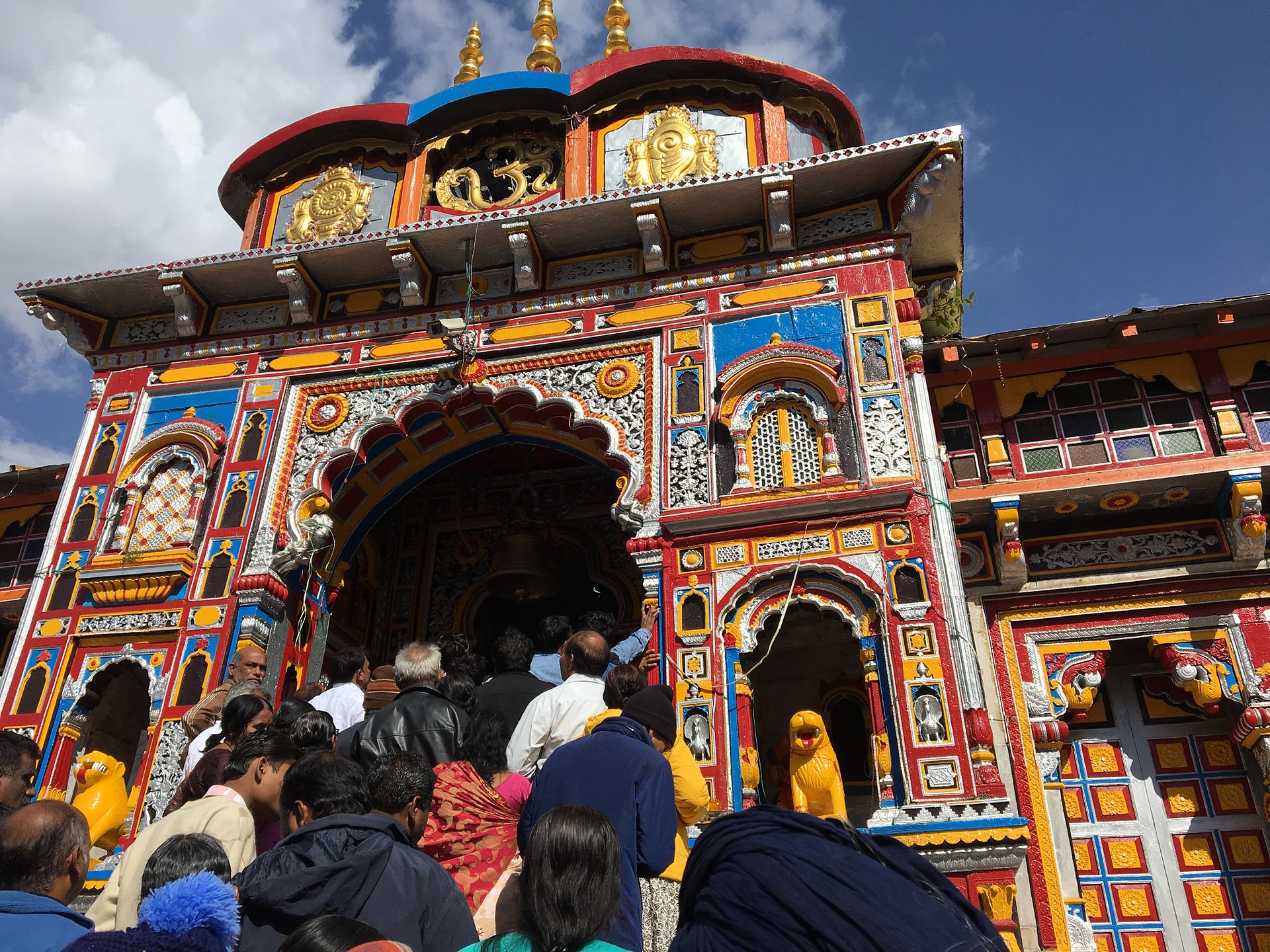 Pilgrims enter the Badrinath Temple in Uttarakhand, India for a darśana Char Dham (Four Holy pilgrimage sites): The famous four holy sites Puri, Rameswaram, Dwarka, and Badrinath (or alternatively the Himalayan towns of Badrinath, Kedarnath, Gangotri, and Yamunotri) compose the Char Dham (four abodes) pilgrimage circuit. Kanwar Pilgrimage: The Kanwar is India's largest annual religious pilgrimage. As part of this phenomenon, millions of participants gather sacred water from the Ganga (usually in Haridwar, Gangotri, Gaumukh, or Sultanganj) and carry it across hundreds of miles to dispense as offerings in Shiva shrines.[16] Old Holy cities per Puranic Texts: Varanasi also known as Kashi (Shiva), Prayagraj, Haridwar-Rishikesh (Vishnu), Mathura-Vrindavan (Krishna), Pandharpur (Krishna), Paithan, Kanchipuram (Parvati), Dwarka (Krishna) and Ayodhya (Rama). Major Temple cities: Puri, which hosts a major Vaishnava Jagannath temple and Ratha Yatra celebration; Katra, home to the Vaishno Devi Temple; Three comparatively recent temples of fame and huge pilgrimage are Shirdi, home to Sai Baba of Shirdi, Tirumala - Tirupati, home to the Tirumala Venkateswara Temple; and Sabarimala, where Ayyappan is worshipped. Shakti Pithas: Another important set of pilgrimages are the Shakti Pithas, where the Mother Goddess is worshipped, the two principal ones being Kalighat and Kamakhya. Pancha Ishwarams - the five ancient Shiva temples of Sri Lanka from classical antiquity. The Murugan pilgrimage route of Sri Lanka, an ancient Arunagirinathar-traversed Pada Yatra route of Tiruppadai temples includes the Maviddapuram Kandaswamy Temple in Kankesanturai, the Nallur Kandaswamy temple in Jaffna, the Pancha Ishwaram Koneswaram temple in Trincomalee, the Verugal Murugan Kovil on the banks of the river Verugal Aru, in Verugal, Trincomalee District, the Mandur Kandaswamy temple of Mandur (Sri Lanka), Thirukkovil Sithira Velayutha Swami Kovil, in Thirukkovil, Batticaloa, the Arugam Bay and Panamai in Amparai district, the Ukanthamalai Murugan Kovil, in Okanda, Kumana National Park and then through the park and Tissamaharama to the deity's holiest site, Kataragama temple, Katirkamam in the South. Islam Main articles: Hajj and Umrah See also: Holiest sites in Islam, Mecca, Medina, and Jerusalem 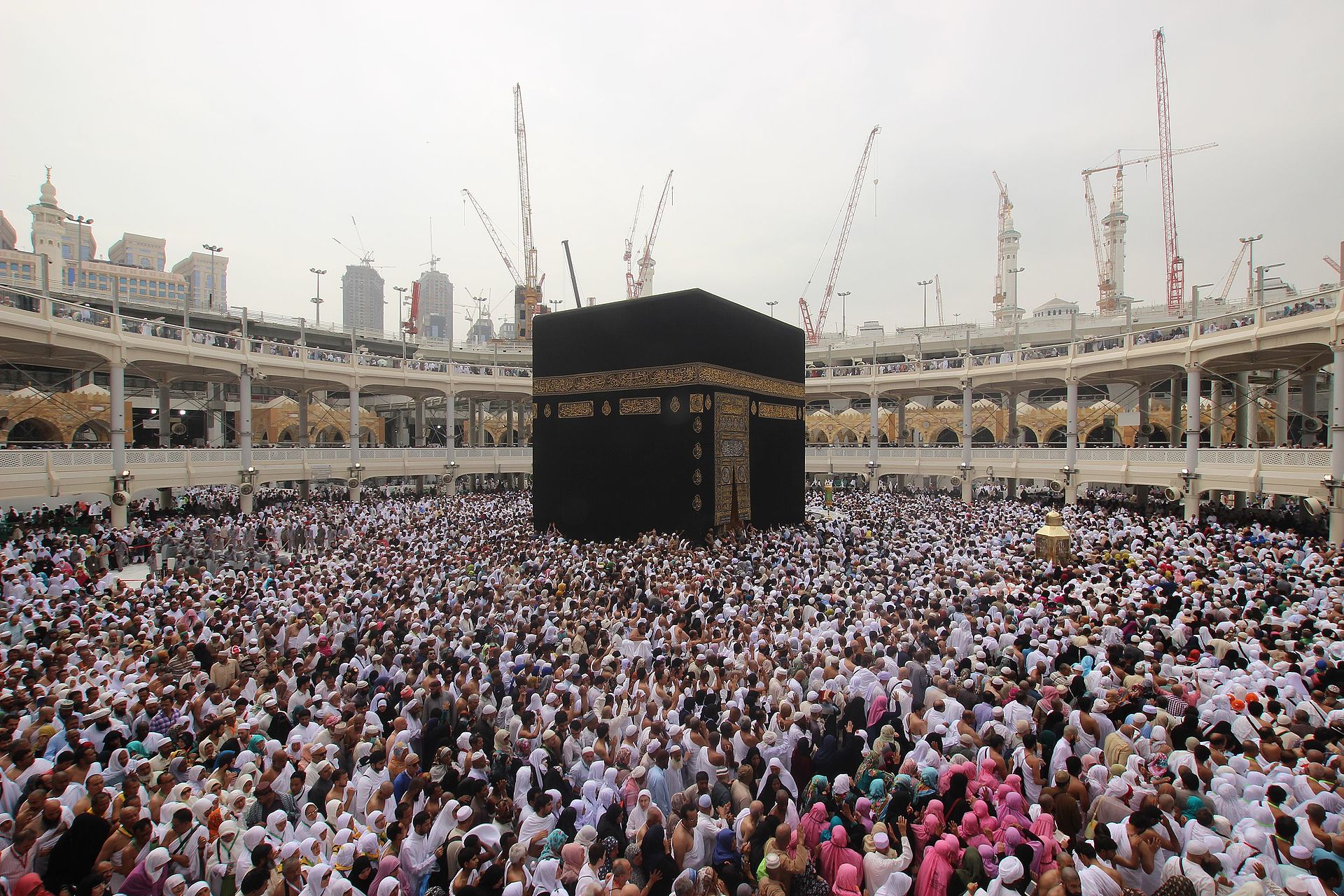 Muslim pilgrims circumambulate the black cube of the Kaaba in the Al-Haram Mosque The Ḥajj (Arabic: حَـجّ, main pilgrimage to Mecca) is one of the five pillars of Islam and a mandatory religious duty for Muslims that must be carried out at least once in their lifetime by all adult Muslims who are physically and financially capable of undertaking the journey, and can support their family during their absence.[17][18][19] The Hajj is one of the largest annual gatherings of people in the world.[20][21] Since 2014, two or three million people have participated in the Hajj annually.[22] The mosques in Mecca and Medina were closed in February 2020 because of the COVID-19 pandemic and the hajj was permitted for only a very limited number of Saudi nationals and foreigners living in Saudi Arabia starting on 29 July.[23] Another important place for Muslims is the city of Medina, the second holiest site in Islam, in Saudi Arabia, the final resting place of Muhammad in Al-Masjid an-Nabawi (The Mosque of the Prophet).[24] The Ihram (white robe of pilgrimage) is meant to show equality of all Muslim pilgrims in the eyes of Allah. 'A white has no superiority over a black, nor a black over a white. Nor does an Arab have superiority over a non-Arab, nor a non-Arab over an Arab - except through piety' - statement of the Prophet Muhammad. 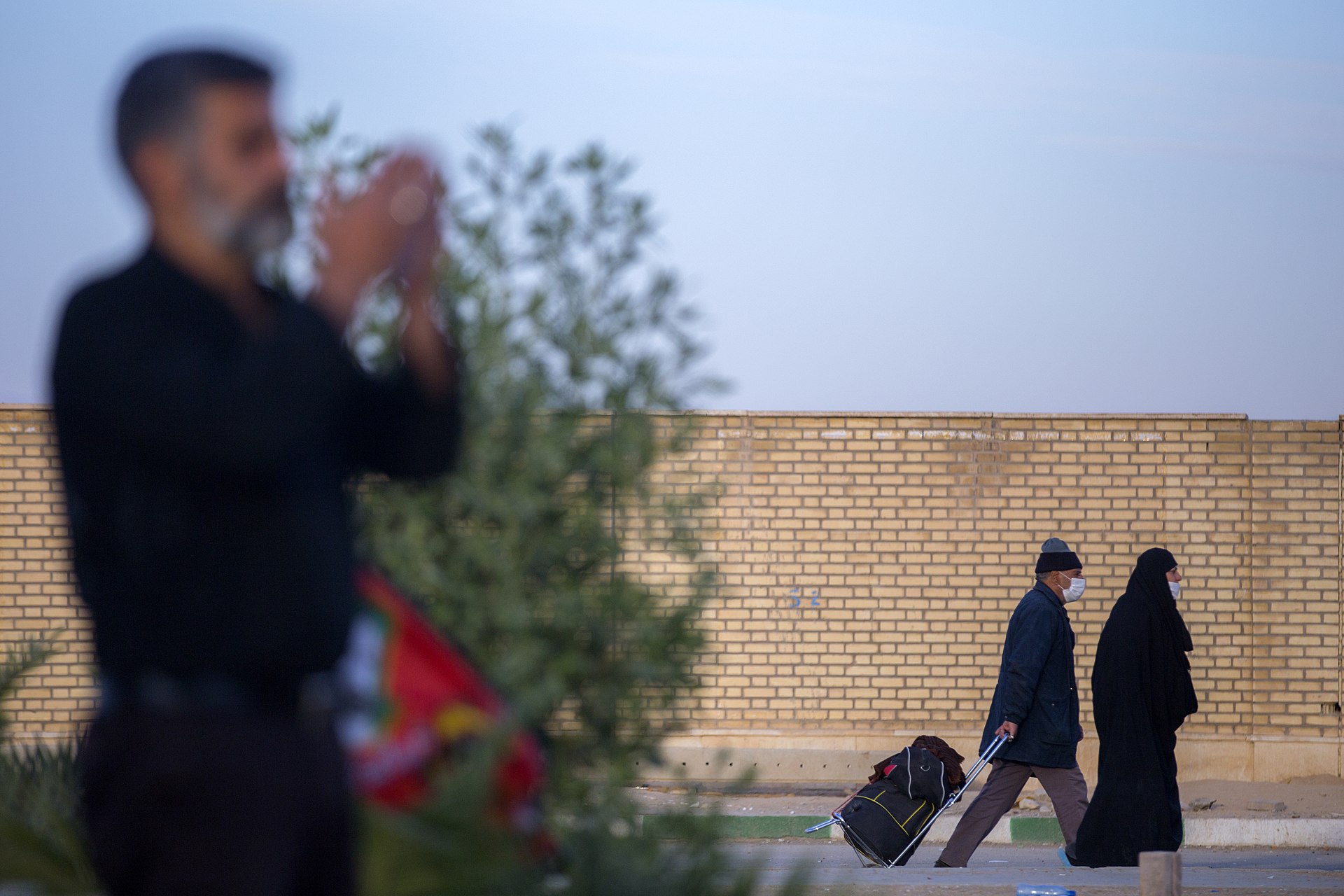 Arba'een pilgrims in Mehran About four million pilgrims participate in the Grand Magal of Touba, 200 kilometres (120 mi) east of Dakar, Senegal. The pilgrimage celebrates the life and teachings of Cheikh Amadou Bamba, who founded the Mouride brotherhood in 1883 and begins on the 18th of Safar.[25] Shia Main articles: Arbaʽeen, Ashura, and Imam Reza Al-Arba‘īn (Arabic: ٱلْأَرْبَـعِـيْـن, "The Forty"), Chehelom (Persian: چهلم, Urdu: چہلم, "the fortieth [day]") or Qirkhī, Imāmīn Qirkhī (Azerbaijani: İmamın qırxı (Arabic: إمامین قیرخی), "the fortieth of Imam") is a Shia Muslim religious observance that occurs forty days after the Day of Ashura. It commemorates the martyrdom of Husayn ibn Ali, the grandson of Muhammad, which falls on the 20th or 21st day of the month of Safar. Imam Husayn ibn Ali and 72 companions were killed by Yazid I's army in the Battle of Karbala in 61 AH (680 CE). Arba'een or forty days is also the usual length of mourning after the death of a family member or loved one in many Muslim traditions. Arba'een is one of the largest pilgrimage gatherings on Earth, in which up to 31 million people go to the city of Karbala in Iraq.[26][27][28][29] The second largest holy city in the world, Mashhad, Iran, attracts more than 20 million tourists and pilgrims every year, many of whom come to pay homage to Imam Reza (the eighth Shi'ite Imam). It has been a magnet for travelers since medieval times.[30][22] Judaism 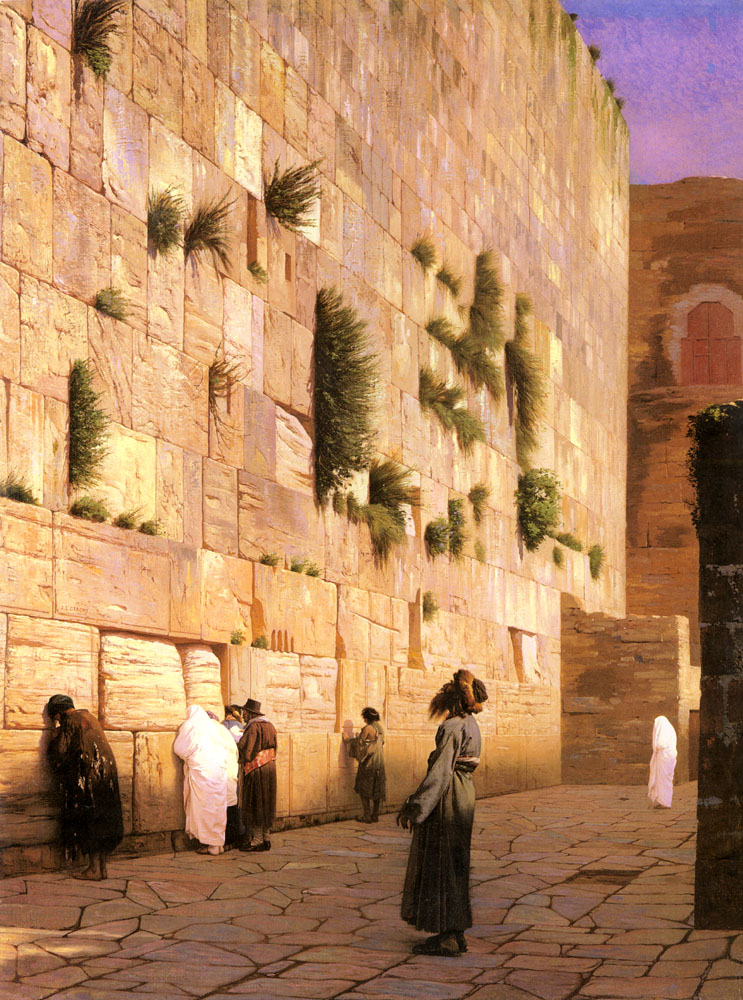 Jews at the Western Wall in Jerusalem during the Ottoman period, 1867 See also: Temple in Jerusalem, Jerusalem in Judaism, and Three Pilgrimage Festivals While Solomon's Temple stood, Jerusalem was the centre of the Jewish religious life and the site of the Three Pilgrimage Festivals of Passover, Shavuot and Sukkot, and all adult men who were able were required to visit and offer sacrifices (korbanot) at the Temple. After the destruction of the Temple, the obligation to visit Jerusalem and to make sacrifices no longer applied. The obligation was restored with the rebuilding of the Temple, but following its destruction in 70 CE, the obligation to make a pilgrimage to Jerusalem and offer sacrifices again went into abeyance.[31] The western retaining wall of the Temple Mount, known as the Western Wall or "Wailing" Wall, is the remaining part of Second Jewish Temple in the Old City of Jerusalem is the most sacred and visited site for Jews. Pilgrimage to this area was off-limits to Jews from 1948 to 1967, when East Jerusalem was under Jordanian control.[32][33] 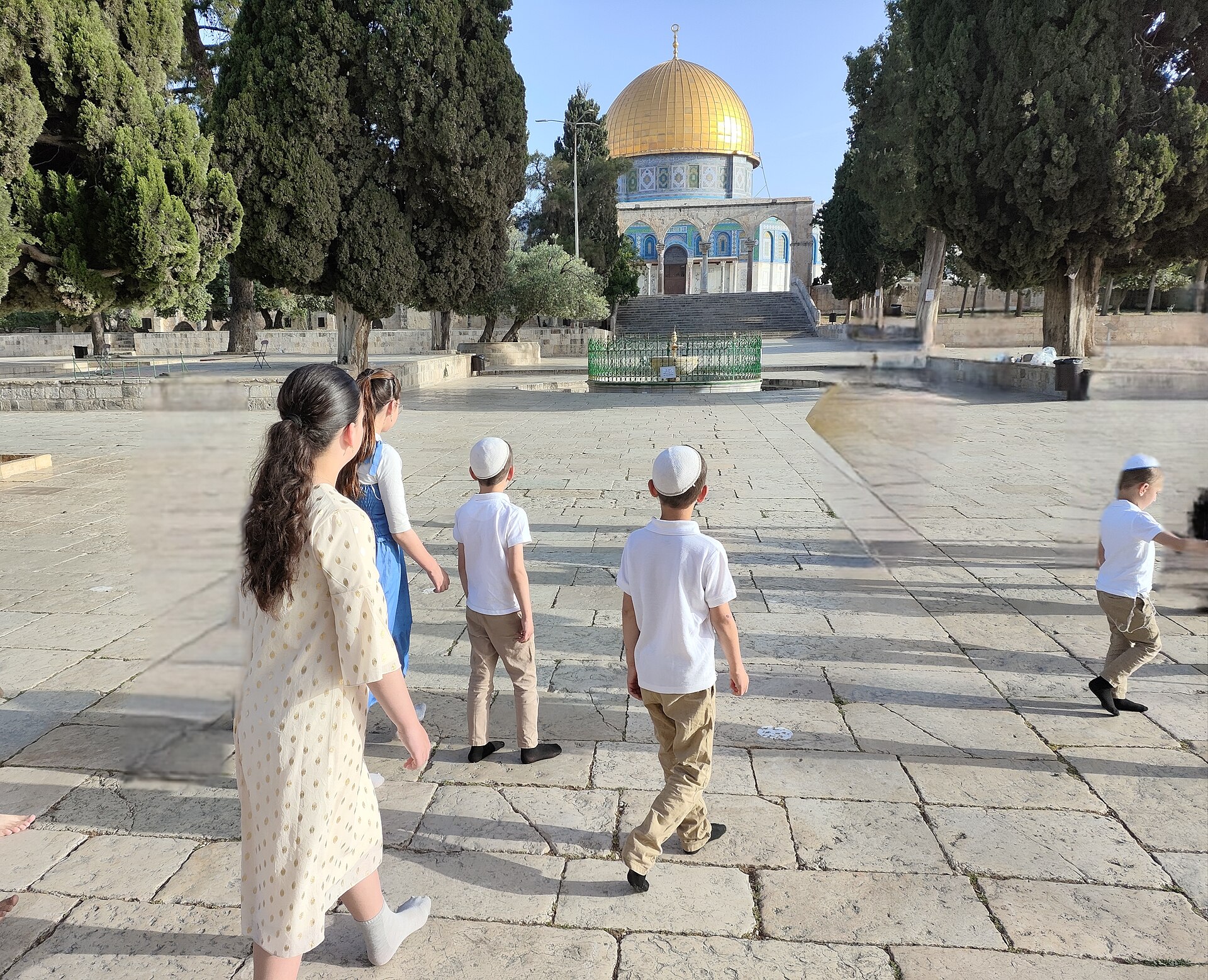 Jewish children on a pilgrimage to the Temple Mount. Passover 2024 There are numerous lesser Jewish pilgrimage destinations, mainly tombs of tzadikim, throughout Israel and Palestine and all over the world, including: Hebron; Bethlehem; Mount Meron; Netivot; Uman, Ukraine; Silistra, Bulgaria; Damanhur, Egypt; and many others.[34] Many rabbis claim that even today, after the destruction of the Temple, there is a mitzvah to make a pilgrimage on holidays.[35] Sikhism 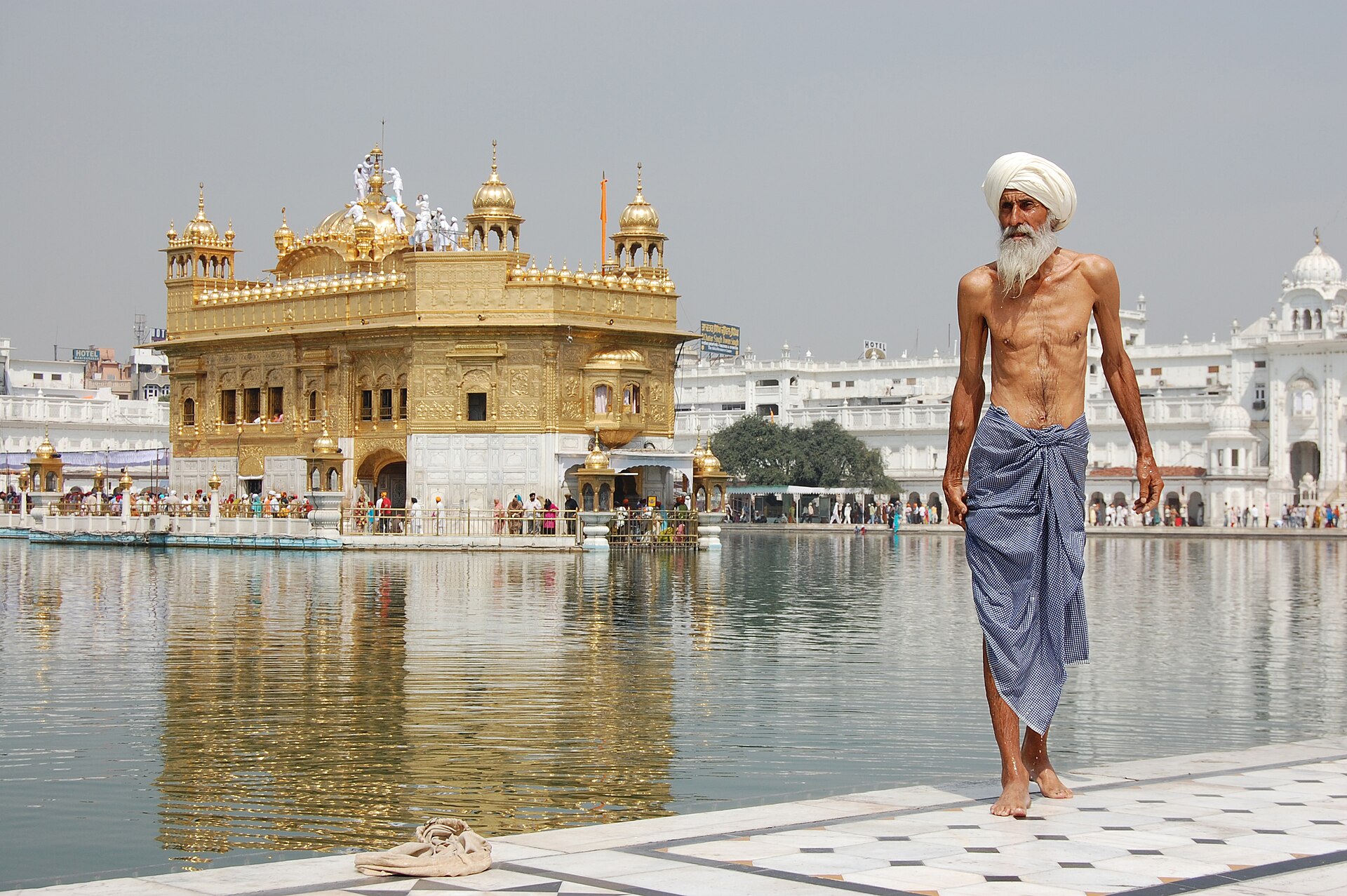 Sikh pilgrim at the Harmandir Sahib (the Golden Temple) in Amritsar, India. Sikhism does not consider pilgrimage as an act of spiritual merit. Guru Nanak went to places of pilgrimage to reclaim the fallen people, who had turned ritualists. He told them of the need to visit that temple of God, deep in the inner being of themselves. According to him: "He performs a pilgrimage who controls the five vices."[36][37] Eventually, however, Amritsar and Harmandir Sahib (the Golden Temple) became the spiritual and cultural centre of the Sikh faith, and if a Sikh goes on pilgrimage it is usually to this place.[38] The Panj Takht (Punjabi: ਪੰਜ ਤਖ਼ਤ) are the five revered gurdwaras in India that are considered the thrones or seats of authority of Sikhism and are traditionally considered a pilgrimage.[39] Taoism 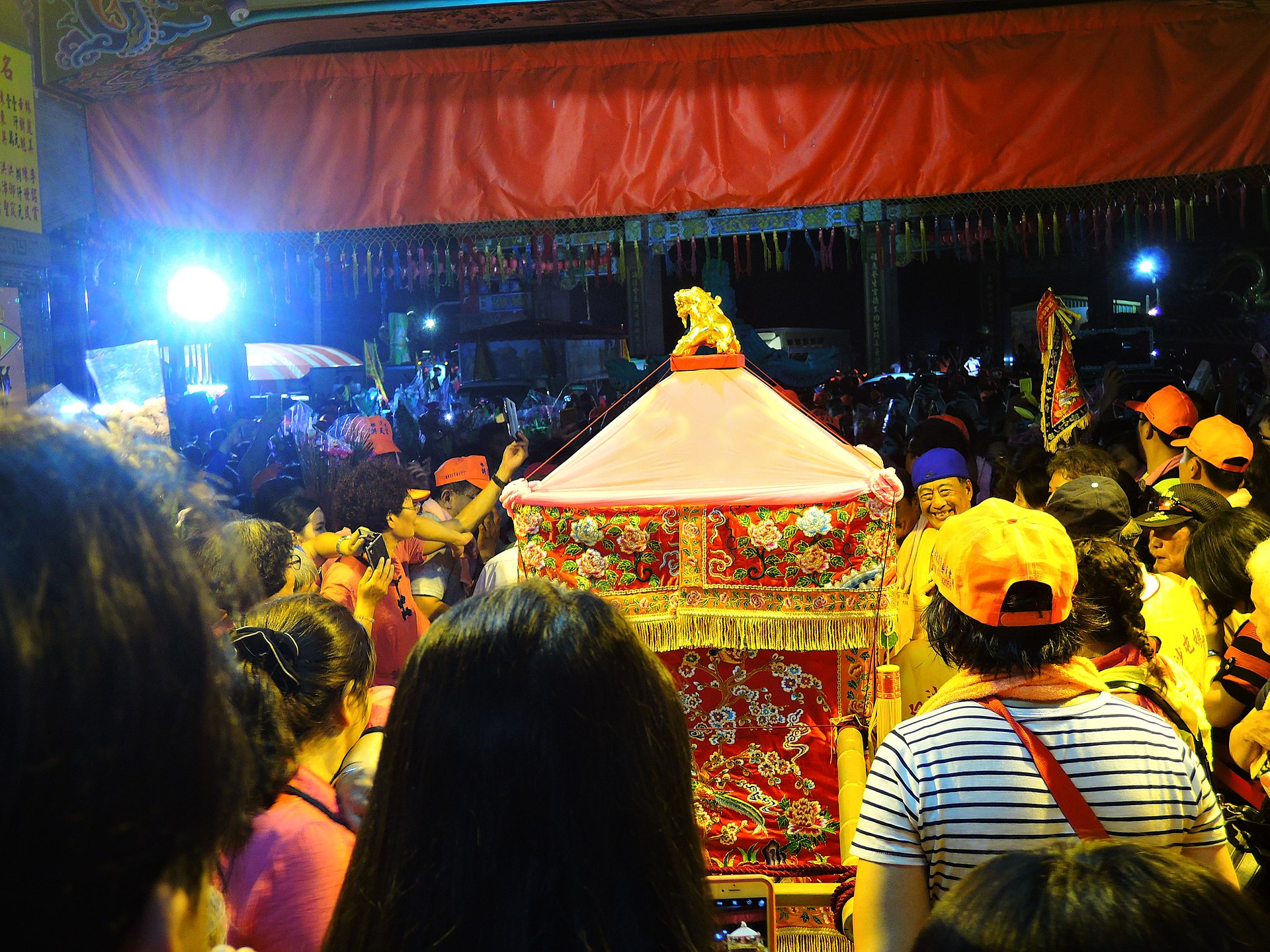 Baishatun Pilgrimage: Mazu and her palanquin Mazu, also spelled as Matsu, is the most famous sea goddess in the Chinese southeastern sea area, Hong Kong, Macau and Taiwan. Mazu Pilgrimage is more likely as an event (or temple fair), pilgrims are called as "Xiang Deng Jiao" (pinyin: xiāng dēng jiǎo, it means "lantern feet" in Chinese), they would follow the Goddess's (Mazu) palanquin from her own temple to another Mazu temple. By tradition, when the village Mazu palanquin passes, the residents would offer free water and food to those pilgrims along the way. There are 2 main Mazu pilgrimages in Taiwan, it usually hold between lunar January and April, depends on Mazu's will. Baishatun Mazu Pilgrimage: this pilgrimage can be traced to 1863, from Baishantun (Miaoli County) to Beigang (Yunlin County) and return, not over a definite route.[40] Dajia Mazu Pilgrimage: from Dajia (Taichung City) to Xingang (Chiayi County) and return, it runs over a definite route.[41] Zoroastrianism 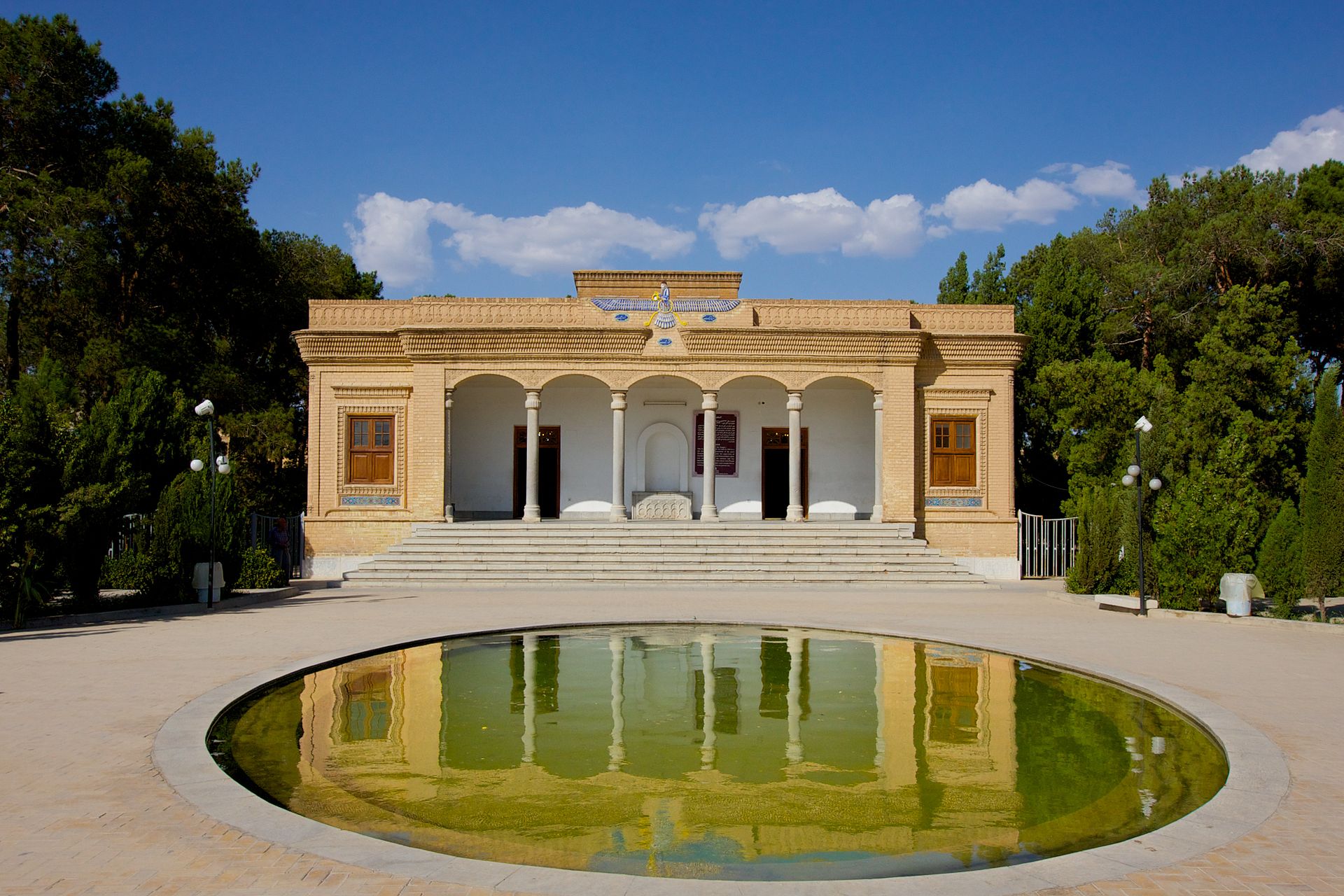 The Yazd Atash Behram in Iran is an Atash Bahram, the highest grade of fire temple in Zoroastrianism In Iran, there are pilgrimage destinations called pirs in several provinces, although the most familiar ones are in the province of Yazd.[42] In addition to the traditional Yazdi shrines, new sites may be in the process of becoming pilgrimage destinations. The ruins are the ruins of ancient fire temples. One such site is the ruin of the Sassanian era Azargoshnasp fire temple in Iran's Azarbaijan Province. Other sites are the ruins of fire temples at Rey, south of the capital Tehran, and the Firouzabad ruins sixty kilometres south of Shiraz in the province of Pars. Atash Behram ("Fire of victory") is the highest grade of fire temple in Zoroastrianism. It has 16 different "kinds of fire", that is, fires gathered from 16 different sources.[43] Currently there are 9 Atash Behram, one in Yazd, Iran and the rest in Western India. They have become a pilgrimage destination.[44] In India the cathedral fire temple that houses the Iranshah Atash Behram, located in the small town of Udvada in the west coast province of Gujarat, is a pilgrimage destination.[44] Other Meher Baba The main pilgrimage sites associated with the spiritual teacher Meher Baba are Meherabad, India, where Baba completed the "major portion"[45] of his work and where his tomb is now located, and Meherazad, India, where Baba resided later in his life. |
古代ギリシャ エレウシスの秘儀には巡礼が含まれていた。エレウシスへの行列はアテナイの墓地ケラメイコスから始まり、参加者はそこから聖なる道(Ἱερὰ δός, Hierá Hodós)に沿ってエレウシスまで歩いた[8]。 バハーイー信仰 主な記事 バハーイ巡礼 バハー・ウッラーは『キターブ=イ=アクダ』の中で、イラクのバグダッドにあるバハー・ウッラーの家とイランのシラーズにあるバーブの家の2箇所への巡礼 を定めた。その後、ʻAbdu'l-Baháはイスラエルのバジにあるバハ・ウッラー廟を巡礼地として指定した。 [9]指定された巡礼地はそれぞれイラクとイランにあるため、現在大多数のバハーイー教徒はアクセスできない。そのため、現在バハーイー教徒が巡礼と称す る場合、イスラエル北西部のハイファ、アクレ、バヒにあるバハーイー世界センターの聖地を訪れる9日間の巡礼を指す[9]。 仏教 主な記事 仏教巡礼  クシナガルのマハーパリニルヴァーナ寺院で発掘された古代の仏像。  ラサに巡礼するチベット人は、多くの場合、全行程にわたって全身で平伏する。 インドとネパールには、ゴータマ・ブッダの生涯と結びついた4つの巡礼地がある: ルンビニ: ルンビニ:ブッダの生誕地(ネパール) ブッダガヤ:悟りを開いた場所(インド、ビハール州、現在のマハーボディ寺院内) サールナート:(正式にはイシパタナ、インド、ウッタル・プラデーシュ州)釈尊が最初の説法(ダンマッカッパヴァッタナ・スッタ)を行い、中道、四諦、八 正道について説いた場所。 クシナラ:(現在のインド、クシナガール)釈迦が大般涅槃に達した(入滅した)場所。 インドとネパールには、ゴータマ・ブッダの生涯にまつわる他の巡礼地がある: サヴァッティ、パタリプッタ、ナーランダ、ガヤ、ヴェーサーリー、サンカシア、カピラヴァストゥ、コサンビ、ラジャガハ。 その他、仏教巡礼地として有名な場所は以下の通り: インド インド:サンチー、エローラ石窟群、アジャンター石窟群、インドの仏教巡礼地も参照のこと。 タイ ワット・プラケオ、ワット・ポー、ワット・ドイ・ステープ、プラ・パトム・チェディ、スコータイ、アユタヤ チベット ラサ(ダライ・ラマの伝統的な住まい)、カイラッシュ山、ナムツォ湖 カンボジア ワット・ボトゥム、ワット・ウーナロム、ワット・ボトゥム、シルバー・パゴダ、アンコール・ワット スリランカ 歯の寺院、ポロンナルワ、(キャンディ)、アヌラーダプラ ラオス パータートルアン、ルアンパバーン マレーシア ケッ・ロク・シー、KL仏教マハー・ヴィハーラ ミャンマー シュエダゴン・パゴダ、マハムニ仏寺院、カイクティヨ・パゴダ、バガン、サガイン・ヒル、マンダレー・ヒル ネパール マヤ・デヴィ寺院、ブッダナート、スワヤンブナート インドネシア:ボロブドゥール、メンドゥット、セウー 台湾 佛光山、法鼓山、中台山、慈済山 香港 ポーリン寺 中国 雲崗、龍門洞窟。四霊山 日本 四国遍路、四国八十八ヶ所巡礼。 日本百観音巡礼:西国、坂東、秩父の巡礼からなる。 西国観音巡礼、関西の巡礼。 坂東三十三ヶ所 関東巡礼 埼玉県・秩父三十四観音巡礼 中国三十三観音巡礼、中国地方の巡礼。 熊野古道 高野山 キリスト教 主な記事 キリスト教の巡礼  エルサレムにある聖墳墓教会は、イエスが磔にされ復活した場所という伝承がある。  ファティマの聖母マリアは、世界最大級の巡礼地(マリア教会)である。 キリスト教の巡礼は、イエスの誕生、生涯、十字架刑、復活に関連する場所に最初に行われた。3世紀のオリゲンの初期の例を除けば、キリスト教の聖地巡礼に 関する記述が残っているのは、聖ジェロームら教父によって巡礼が奨励され、コンスタンティヌス大帝の母である聖ヘレナによって確立された4世紀以降のこと である[10]。 キリスト教の巡礼の目的は、ローマ教皇ベネディクト16世によってこのように要約されている: 巡礼とは、単に自然や芸術、歴史などの宝物を鑑賞するためにその地を訪れることではない。巡礼に行くということは、単に自然や芸術や歴史の宝物を鑑賞する ためにその地を訪れることではありません。巡礼に行くということは、神がご自身を現された場所、神の恵みが特別な輝きを放ち、信じる人々の間に回心と聖性 の豊かな実りをもたらした場所で、神に出会うために自分自身を一歩踏み出すことを本当に意味するのです。とりわけ、キリスト者は聖地巡礼に出かけ、主の受 難、死、復活にまつわる場所を訪れる。ペトロとパウロの殉教の地であるローマや、聖ヤコブの思い出の地であり、使徒の信仰と愛の証しによって精神を強めた いと願う世界中の巡礼者を受け入れているコンポステーラにも巡礼に行く[11]。 巡礼は、ローマや使徒、聖人、キリスト教殉教者ゆかりの地、聖母マリアの出現の地などにも行われており、現在も行われている。人気のある巡礼の旅は、スペ インのガリシア地方にある、使徒ヤコブの祠があるサンティアゴ・デ・コンポステーラ大聖堂を目指す聖ヤコブの道である。マーストリヒト、アーヘン、コルネ リミュンスターという近隣の3つの町では、7年ごとに合同巡礼が行われ、多くの重要な聖遺物を見ることができた(参照:聖遺物巡礼、マーストリヒト)。 チョーサーの『カンタベリー物語』には、カンタベリー大聖堂やトマス・ベケット廟に向かうキリスト教巡礼者の物語が描かれている。ラテンアメリカでは、マ リア巡礼は今でも非常に人気がある。 ヒンドゥー教 こちらも参照: ティルタ(ヒンドゥー教)、ヒンドゥー教の巡礼地、ヒンドゥー教§巡礼、ヤートラも参照。  クンブ・メラ カレル・ヴェルナーの『Popular Dictionary of Hinduism』によると、「ヒンドゥー教の巡礼地のほとんどは、さまざまな神々の生涯にまつわる伝説的な出来事と関連している。ほとんどのヒンドゥー 教の巡礼地は、さまざまな神々の生涯にまつわる伝説的な出来事に関連している......ほとんどどんな場所でも巡礼の中心になりうるが、ほとんどの場 合、聖なる都市、川、湖、山である」[12]。ほとんどのヒンドゥー教徒は、自分の住んでいる地域内の聖地を訪れる。  プラヤーグ・クンブ・メラ期間中のガンジス川沿いの巡礼者たち クンブ・メラ:クンブ・メラは、巡礼者が聖なる川で沐浴するために集まる、世界最大級の人間の集まりである[13][14][15]。  インドのウッタラーカンド州にあるバドリナート寺院でダルシャナを受ける巡礼者たち。 チャール・ダム(四大聖地巡礼): プリー、ラーメスワラム、ドワルカ、バドリナート(またはヒマラヤのバドリナート、ケダルナート、ガンゴートリー、ヤムノートリー)は、チャール・ダム (四大聖地)巡礼の道である。 カンワール巡礼: カンワール巡礼は、毎年行われるインド最大の宗教巡礼である。この現象の一環として、何百万人もの参加者がガンガーから聖水を集め(通常はハリドワール、 ガンゴトリ、ガウムク、スルタンガンジ)、それを何百マイルも運んでシヴァ神の祠にお供えする[16]。 プラーナ教典に登場する古い聖地 バラナシはカシ(シヴァ神)、プラヤグラージ、ハリドワール=リシケシ(ヴィシュヌ神)、マトゥラー=ヴリンダーヴァン(クリシュナ神)、パンダルプール (クリシュナ神)、パイタン、カンチプラム(パールヴァティ神)、ドワルカ(クリシュナ神)、アヨーディヤ(ラーマ神)とも呼ばれる。 主要な寺院都市 比較的最近有名になり、多くの巡礼者が訪れるようになったのは、シルディのサイ・ババが祀られているシルディ、ティルマラ・ヴェンカテーシュワラ寺院があ るティルパティ、そしてアヤッパンが祀られているサバリマラである。 シャクティ・ピタ:母なる女神が祀られているシャクティ・ピタも重要な巡礼地のひとつで、カリガートとカマキヤがその代表的なものである。 パンチャ・イシュワラムス:スリランカに古くからある5つのシヴァ寺院。 スリランカのムルガン巡礼路は、ティルッパダイ寺院の古代アルナギリナタールが通ったパダ・ヤトラ・ルートであり、カンケサントゥライのマヴィダプラム・ カンダスワミ寺院、ジャフナのナッルル・カンダスワミ寺院、トリンコマリーのパンチャ・イシュワラム・コネスワラム寺院、ヴェルガルのヴェルガルアル川岸 にあるヴェルガル・ムルガン・コヴィルが含まれる、 トリンコマリー地区、マンドゥール(スリランカ)のマンドゥール・カンダスワミ寺院、バティカロア県ティルコヴィルのティルコヴィル・シティラヴェラユ タ・スワミ・コヴィル、アンパライ県のアルガム湾とパナマイ、 オカンダのウカンタマライ・ムルガン・コヴィル、クマナ国立公園、そして公園とティッサマハラマを通って、神の最も神聖な場所であるカタラガマ寺院、南部 のカティルカマムへ。 イスラム教 主な記事 ハッジとウムラ こちらも参照: イスラム教の聖地、メッカ、メディナ、エルサレム  イスラム教の巡礼者がアル・ハラーム・モスクの黒い立方体のカーバを一周する。 Ḥajj(アラビア語: حَـجّ、メッカへの主な巡礼)は、イスラム教の5本柱の1つであり、ムスリムにとって必須の宗教的義務である。 [17][18][19]ハッジは毎年行われる世界最大級の人の集まりである[20][21]。 2014年以降、毎年200万人か300万人がハッジに参加している[22]。2020年2月にはCOVID-19の流行によりメッカとメディナのモスク が閉鎖され、7月29日からサウジアラビア国民とサウジアラビア在住の外国人のごく限られた人のみにハッジが許可された[23]。 イスラム教徒にとってもうひとつ重要な場所は、イスラム教で2番目に神聖な場所であるサウジアラビアのメディナ市であり、アル・マスジド・アン・ナバウィ (預言者のモスク)にあるムハンマドの最後の休息地である[24]。 イフラーム(巡礼の白い衣)は、アッラーの目から見てすべてのムスリム巡礼者が平等であることを示すためのものである。白人が黒人に優越することはなく、 黒人が白人に優越することもない。アラブ人が非アラブ人に優越することも、非アラブ人がアラブ人に優越することもない。  メヘランのアルバイーン巡礼者たち セネガルのダカールの東200キロ(120マイル)にあるトゥバの大巡礼には、約400万人の巡礼者が参加する。この巡礼は、1883年にムーリデ兄弟団 を創設したシェイク・アマドゥ・バンバの生涯と教えを祝うもので、サファルの18日に始まる[25]。 シーア派 主な記事 アーバイン、アシュラ、イマーム・レザ アラビア語: ٱلْأَرْبَـيْـعِـن、「四十日」)、チェヘロム(ペルシア語: چهلم、ウルドゥー語: ـلم、「四十日」)、またはキルキー、イマームン・キルキー(アゼルバイジャン語: İmamın qıkhī: アゼルバイジャン語:İmamın qırxı(アラビア語:إمامین قیرخی)、「イマームの40日目」)は、シーア派ムスリムの宗教行事で、アシュラの日の40日後に行われる。ムハンマドの孫フサイン・イブン・アリー の殉教を記念するもので、サファル月の20日か21日に行われる。イマーム・フサイン・イブン・アリーと72人の教友は、61AH(西暦680年)のカル バラの戦いでヤズィード1世の軍勢に殺された。Arba'eenまたは40日間は、多くのイスラム教の伝統において、家族や愛する人が亡くなった後の通常 の喪の長さでもある。アルバイーンは地球上で最大の巡礼の集まりのひとつであり、3100万人もの人々がイラクの都市カルバラを訪れる[26][27] [28][29]。 世界第二の聖地であるイランのマシュハドには、毎年2,000万人以上の観光客や巡礼者が訪れ、その多くはイマーム・レザ(シーア派第8代イマーム)に敬 意を表するために訪れる。中世の時代から旅行者を魅了してきた[30][22]。 ユダヤ教  オスマン帝国時代、エルサレムの西の壁にいたユダヤ人(1867年) こちらも参照: エルサレムの神殿、ユダヤ教におけるエルサレム、3つの巡礼祭 ソロモン神殿が建っていた時代、エルサレムはユダヤ教の宗教生活の中心であり、過越の祭り、シャブオット、スッコットの三巡礼祭が行われる場所であった。 神殿が破壊された後、エルサレムを訪れ、いけにえを捧げる義務はなくなった。この義務は神殿の再建によって復活したが、CE70年の神殿破壊後は、エルサ レムへの巡礼といけにえを捧げる義務は再び消滅した[31]。 西の壁」または「嘆きの壁」として知られる神殿山の西側の擁壁は、エルサレム旧市街に残る第二次ユダヤ教神殿の一部であり、ユダヤ人にとって最も神聖で訪 れるべき場所である。東エルサレムがヨルダンの支配下にあった1948年から1967年まで、この地域への巡礼はユダヤ人に禁じられていた[32] [33]。  神殿山を巡礼するユダヤ人の子供たち。2024年の過越祭 イスラエルとパレスチナ、そして世界中には、主にツァディキムの墓など、あまり知られていないユダヤ人の巡礼地が数多くある: ヘブロン、ベツレヘム、メロン山、ネティヴォ、ウクライナのウマン、ブルガリアのシリストラ、エジプトのダマンフール、その他多数[34]。 多くのラビは、神殿が破壊された今日でも、祝日に巡礼するミツヴァがあると主張している[35]。 シク教  インド、アムリトサルのハルマンディル・サーヒブ(黄金寺院)でのシーク教徒の巡礼者。 シーク教は巡礼を精神的な功徳行為とは考えていない。グル・ナーナクは、儀式主義者と化した堕落した人々を取り戻すために巡礼地に赴いた。彼は彼らに、自 分自身の内奥にある神の神殿を訪れる必要性を説いた。彼によれば 「五つの悪徳を制する者は巡礼を行う」[36][37]。 しかし最終的には、アムリトサルとハルマンディル・サーヒブ(黄金寺院)がシク教の精神的・文化的中心地となり、シク教徒が巡礼に行く場合はたいていこの 場所である[38]。 パンジ・タクト(パンジャブ語:ਪੰਚ)はインドにある5つのグルドワラで、シク教の王座または権威の座とされ、伝統的に巡礼地とされている[39]。 道教  白沙屯巡礼: 媽祖と輿 媽祖は媽祖とも表記され、中国南東部の海域、香港、マカオ、台湾で最も有名な海の女神である。 媽祖巡礼はイベント(または廟の縁日)である可能性が高く、巡礼者は「香登焦」(ピンイン:xiāng dēng jiǎo、中国語で「提灯の足」を意味する)と呼ばれ、女神(媽祖)の輿を追って、自分の廟から別の媽祖廟に向かう。媽祖の輿が通過する際には、住民たち は巡礼者たちに水や食べ物を無料で提供するという伝統があります。 台湾の媽祖巡礼は主に2種類あり、旧暦の1月から4月にかけて行われます。 白沙屯媽祖巡礼:この巡礼は1863年に始まり、白沙屯(苗栗県)から北港(雲林県)までの往復で、明確なルートはありません[40]。 大甲媽祖巡礼:大甲(台中市)から新港(嘉義県)までの往復。 ゾロアスター教  イランのヤズド・アタシュ・ベーラムはアタシュ・ベーラムであり、ゾロアスター教における最高位の火の寺院である。 イランでは、いくつかの州にピルと呼ばれる巡礼地があるが、最も親しまれているのはヤズド州である[42]。伝統的なヤズドの祠堂に加え、新たな遺跡が巡 礼地になりつつある場合もある。その遺跡とは、古代の火の神殿跡である。そのひとつが、イランのアザルバイジャン州にあるサーサーン朝時代のアザルゴシュ ナスプ火寺跡である。他にも、首都テヘランの南にあるレイの火神殿跡や、シラーズの南60キロにあるパールス州のフィルーザバード遺跡がある。 アタシュ・ベーラム(「勝利の火」)は、ゾロアスター教における最高級の火神殿である。現在、イランのヤズドに1つ、西インドに残りの9つのアタシュ・ ベーラムがある。それらは巡礼地となっている[44]。 インドでは、グジャラート州西海岸のウドヴァダという小さな町にあるイランシャー・アタシュ・ベーラムの聖堂が巡礼地となっている[44]。 その他 メヘルババ スピリチュアル・ティーチャーであるメヘルババに関連する主な巡礼地は、ババがその仕事の「主要な部分」[45]を完成させ、現在墓があるインドのメヘラ バードと、ババが晩年に住んだインドのメヘラザードである。 |
| https://en.wikipedia.org/wiki/Pilgrimage |
|
Compostela
"Ad vesperas Sancti Iacobi": I. Hymnus peregrinorum "Dum pater
familias" Codex
Calixtinus.
こ の写本には3声のための最初の既知の作品であるconductus Congaudeant catholici(すべてのカトリック教徒が共に喜べ)が含まれているが、3声すべてを一緒に演奏すると極度の不協和音が発生するため、一部の学者は、 これは当初の意図ではなかったと主張し、現在でも意見が分かれている
リ ンク
文 献
そ の他の情報
Copyleft, CC, Mitzub'ixi Quq Chi'j, 1996-2099
☆
 ☆
☆